All published articles of this journal are available on ScienceDirect.
Intelligent System for Transportation Mode Selection in ASEAN Countries
Abstract
Association of Southeast Asian Nations: ASEAN is an organization of ten countries in Southeast Asia consisting of Indonesia, Malaysia, the Philippines, Singapore, Brunei, Myanmar, Cambodia, Laos, Vietnam and Thailand. One of the major purposes of Asean is to create the Asean Economic Community: AEC as an economic organization. The mission of the AEC is to develop a single market and develop production base to be stable prosperous, highly competitive and economically, integrated with effective facilitation for trade and investment including a free flow of goods, services, investment, skilled labors and capital . This paper focuses on investigating the constraint within the three major modes of transportation (Air Sea and Truck) and reviewing the major factor influenced mode selection of the trading organization in Asean countries. Whilst constraints and complexities exist particularly within different countries, products values, lead time, a lack of knowledge on the condition of each transportation mode of the Small and Medium Enterprise (SME). At the time for those requirements can result in business limitation and restrictions. The results of research will lead to the design of an intelligent transportation system program that will not only illustrate solution for the trading organization in Asean countries but also provide variable costing and accurate transit time as management tools for users.
1. INTRODUCTION
There are three major modes of transportation within ASEAN (Air, Sea & Truck) (Fig. 1). Outlines variety of current constraints which are expected to increase in the future. The volume of trade among the countries in ASEAN that consist of Myanmar, Laos, Thailand, Vietnam, Cambodia, Malaysia, Singapore, Indonesia, Philippines and Brunei has been increased, therefore, transportation performance across these countries has become more important and highly complex. In fact, physical supply and physical distribution is one of the major challenges of operations between the countries because ASEAN is being one of the large business sectors in the world market.
The ASEAN Free Trade Area (AFTA) which has been established under Free Trade Agreements (FTAs), in order to increase negotiation ability for ASEAN countries with the other countries such as European Union, China, Australia and New Zealand is also expected to face with the challenges in the transportation sector.
The existing problems of transportation mode selection among users in ASEAN are: 1) various of transportation liability and lead time, 2) several supported documents and permission required on specific type of products.3) lack of knowledge of transportation mode requirements among Small and Medium Enterprise (SME) and 4) several unforeseen costs
An example of challenges in each mode of transportation in Thailand are 1) Ocean transportation creates long lead times and inflexibility schedule2) Air Transportation is costly and limitation of space 3) Land transportation is risky and uncertain lead time 4) Shipper keeps large stock that resulting in inventory cost 5) Consignee keeps surplus inventory for supporting production plan.A highly effective transportation system has been identified as Just-in-Time (JIT) deliveries involving delivery at the right place with the right thing and the right cost. The overall frame work is based on flexible factors such as quantity of product, lead time, and acceptable costs that relate to several environments and constrains of each mode of transportation. Furthermore, it considers the case where a user wants to transport goods from origin to destination whilst facing several and different constraints of each mode of transportation to each destination. In addition, the challenge is to create a systematic tool that is able to handle the complexity that is inherent in such environment to construct alternative solution and result in the correct decision making on transportation mode selection process for the trading organization as the users in Asean countries.

The constrain in three major modes of transportation in ASEAN.
Asean Economic Community (AEC).The Association of Southeast Asian Nations, commonly abbreviated ASEAN is a geo-political and economic organization of ten countries located in Southeast Asia, which was formed on 8 August 1967 by Indonesia, Malaysia, the Philippines, Singapore and Thailand. Other member countries which are Brunei, Burma (Myanmar), Cambodia, Laos, and Vietnam had joined in the latter year. It focuses on acceleration of economic growth, social progress, cultural development among its members, the protection of regional peace and stability, and to provide opportunities for member countries to discuss independently. ASEAN covers an area of 4.46 million km², 3% of the total land area of Earth, with a population of approximately 600 million people, and 8.8% of the world population. In 2010, its nominal GDP had grown to US$1.8 trillion. Once ASEAN became a single entity, it would be ranked as the ninth largest economy in the world.
ASEAN has emphasized regional cooperation in the “three pillars” of security, sociocultural and economic integration. The regional grouping has made the most progress in economic integration, aiming to create an ASEAN Economic Community (AEC) by 2015 with main objectives which are:
- Single market and production base
- Highly competitive economic region
- Region of equitable economic development
- Region fully integrated into the global economy
Since 2007, the ASEAN countries gradually lowered their import duties among members and targeted to zero duties for the majority of intra ASEAN imported products at 2015. Since 2011, AEC had agreed to strengthen the position and increase the competitive edges of small and medium enterprises (SME) in the ASEAN region.
Resulting from the mentioned conditions and factors, researchers have been researched for the major factors influencing the decision to select the transportation mode of each country in ASEAN to develop systematic tools that will help user to make a proper decision to meet their requirements with acceptable cost and transit time. The user can get the appropriate information to make decisions quickly under competitive costs.
2. LITERATURE REVIEW
The literature review of the researches in the past found that Iseki, Miller (2007) [1] evaluated tool for transport transit agencies to access the quality of services with numerous criteria from the users, operators and neighboring communities. However T.Litman (2008) [2] considered transportation performance evaluatation based on the ability to reach desired services and activities rather than just physical movement. In another way Eboli and Mazzulla (2011) [3] evaluated transit service quality with an intermediate value between subjective and objective measure. By the way Levinson (2006) [4] argued that transportation network planning decisions made at one point of time may result in profound impacts in the future. This paper analyzes the relationships between network supply and travel demand, and describes a road development and degeneration mechanism microscopically at the link level. By the way Levinson and Yerra (2007) [5] had investigated the self-organization of surface transportation networks. Utilization of a travel demand model coupled with revenue, cost, and investment models, experiments are run under a variety of parameters on a grid network. This research thus finds that roads and hierarchies, which are often thought to be the product of conscious design, can also arise without such intention.
However Kale et al. (2007) [6] mentioned that the establishment of private communities on Internet-based transportation networks is a relatively new showing that cooperating with shippers in their private communities with reliable carriers may be an effective tools. Qu et al. (2008) [7] stated that multimodal transportation is a complex network, in which all the components should be seamlessly linked and efficiently coordinated. The transport mode selection in multimodal transportation is studied within the framework of multicriteria decision making (MCDM). The theoretical basis for feedforward artificial neural network (FANN) to solve this MCDM problem is presented. Empirical results evidently show this MCDM method is an accurate, flexible and efficient transport mode selection model. By the way Engebrethsen (2009) [8] proposed that selecting the right product and service, suppliers can reduce the costs and improve the corporate competitiveness. This thesis examines the transportation mode selection decision in quantitative supply chain planning models. The test results show that the size of the potential savings depends on the problem parameters, and the transshipment policies and transportation strategies applied. Meanwhile Tuna and Silan (2002) [9] mentioned that freight transportation selection has critical importance to the shippers in terms of achieving high customer service level, cost savings and efficiency in the overall supply chain. On the other hand, providers of freight transportation services have been interested in finding out the salient freight transport selection factors of shippers in order to be competitive within freight transport market. The analysis found that reliability and competence was the most important factor. However SCRIBD (2010)[10] mentioned that it was thought to be a challenge to develop such an expert system about a decade ago. In the beginning, artificial intelligence was considered to be used only for military based operations but nowadays it is being widely used in all sorts of applications. As well as Lemer (2007) [11] described research conducted to develop a knowledge-based expert system decision-support tool for recommending speed limits in speed zones on highways and local roads, which are considered credible and enforceable. Particularly interesting is A. Lazans, N. Karacapilidis and Y. Pirovolakis (2006) [12] that integrated recommendation technique, which combines the advantages of collaborative filtering and knowledge based recommendation in a web-based platform as well as N. Karacapilidis (2005) [13] that developed web-based on the cooperate of customer, carrier and broker that act as intermediate party.
Conclusion from the preliminary research, the researchers found some gap of the study area and interested in constraints that are the main factors which influence the real in order to decide in which trend that has met with several success. This paper suggests that shippers may indeed receive those benefits by format to choose the appropriate transport for each service user. This research will analyze to bring the major factor to design the program as a tool to introduce basic information in order to decide mode of transportation properly. Fast and economical as the framework and methodology that have been set up as follows.
3. FRAMEWORK AND METHODOLOGY.
Refer to the research objective and related constraints in three major modes of transportation (Fig. 1). Researcher organized framework and methodology (Fig. 2), in the first part described the background and introduces the objectives of this research; the second part presented the source of population and sample and analytical methods; the third part describes the data and investigate the influent factor by Delphi Technique; the fourth part analyzed the results of data applied to compare literature and develop a Decision Tree Diagram; the fifth part develop Intelligent System. The Intelligent System Program will have trial with the actual case and discusses with users for the further required to generalizing the concept to summarize the conclusions of the research.
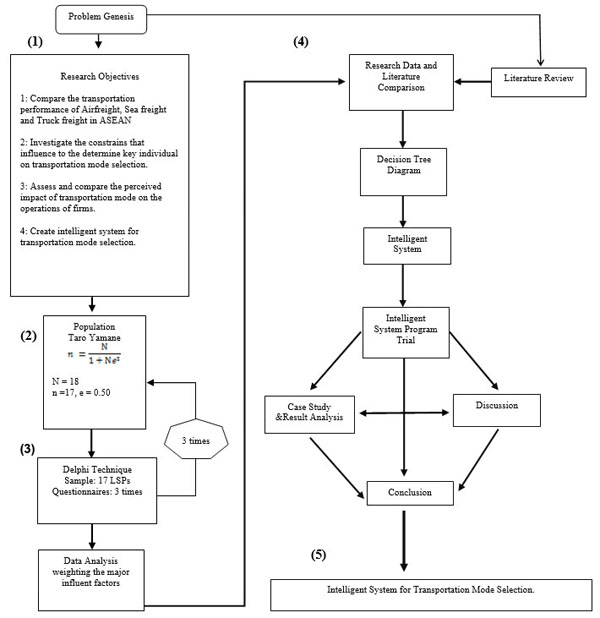
Framework and methodology.
3.1. Objective
The primary objectives of this research are four-folds;
- Compare the transportation performance of Airfreight, Sea freight and Truck freight from Thailand to other 9 countries in ASEAN.
- Investigate the constraints and major factor which influence to determine the key individual on transportation mode selection of each destination from Thailand.
- Assess and compare the perceived impact of transportation mode on the operations of firms.
- Create intelligent system for transportation mode selection.
3.2. Population and Sample Size
In this research, researchers will design a program to create a prototype expert system. Since the condition of user of the pursuit of the factors influencing the decision to choose a significant edge transport voucher, it is necessary. Researchers have made in-depth interviews with branch specialists who work or have years of experience related to the job, consider shipping who present coverage 3 modes of transportation in ASEAN markets from leading companies. (Table 1) Multinational companies in Thailand with the selection of samples by means of a specific sample selection (Purposive Sampling) of 17 companies in order to reduce the discrepancies that occur with the rate reduced by filling out a questionnaire and reply via email. Several documents used to collect insights with experts only one side will include a number of questionnaire 3 series 1 set by the query open-ended in order to gather the opinions of experts from a large section of the questionnaire. The questionnaires are 2 sets of categories about scale value (Rating Scale) 5 and 3 series to be an open-ended question, which is a deep concern because of the 2 sets of questionnaire.
3.3. Delphi Technique
According to a wide variety of opinions could be a cause of distorted information. Asking repeatedly to confirm the answer and have a chime of the experts are one of the methods to obtain such information. The Delphi technique via questionnaire is an essential tool. The format of the questionnaire, open-ended questionnaire aims to gather opinions from a large group of experts for a query in the second cycle, from the development of answers to the questionnaire in the first cycle. By bringing all opinions from experts to create a synthesis is the standard type of open-ended questionnaires about the value and sent to experts, prioritize, or forecasting trends in each. To run the query in the round 3 will be using both categories is open-ended questionnaire and the questionnaire at the end of the closed type article about value (typically using standard estimates the 5 levels) The developed technique, Delphi traditional dating to the first round storage using open-ended questionnaires. Best laps later to use the closed end to keep the data in the first round to be using tointroduce each of the answers received from the questionnaires which all 2 to calculate the statistical value. Issues that must be considered in the preparation of the questionnaire is to select a value which is used as a fallback information such as median (Median) in the mode (Mode), and the radar between quartile (Interquartile Range: IR) or a frequency.
Data analysis.
| Freight Charge | Transit Time | Volume | Weight | Mode Selection | Value of Merchandise | General Goods | Sensitive Goods | Insurance Requirements | |
|---|---|---|---|---|---|---|---|---|---|
| Expert .1 | 4 | 4 | 4 | 4 | 4 | 4 | 3 | 4 | 4 |
| Expert.2 | 5 | 5 | 4 | 4 | 4 | 5 | 4 | 4 | 4 |
| Expert .3 | 5 | 5 | 3 | 3 | 5 | 3 | 5 | 3 | 4 |
| Expert.4 | 5 | 5 | 4 | 4 | 5 | 3 | 4 | 3 | 4 |
| Expert.5 | 5 | 5 | 4 | 4 | 4 | 4 | 4 | 4 | 3 |
| Expert.6 | 5 | 5 | 4 | 4 | 4 | 4 | 4 | 3 | 4 |
| Expert.7 | 5 | 4 | 3 | 3 | 5 | 3 | 5 | 3 | 5 |
| Expert.8 | 4 | 4 | 4 | 4 | 4 | 5 | 5 | 4 | 5 |
| Expert.9 | 5 | 5 | 4 | 4 | 3 | 3 | 4 | 3 | 4 |
| Expert.10 | 4 | 4 | 3 | 4 | 5 | 5 | 5 | 4 | 4 |
| Expert.11 | 5 | 4 | 4 | 3 | 4 | 3 | 3 | 3 | 4 |
| Expert.12 | 5 | 5 | 4 | 4 | 3 | 3 | 5 | 4 | 5 |
| Expert.13 | 5 | 4 | 3 | 4 | 4 | 4 | 5 | 3 | 4 |
| Expert.14 | 4 | 5 | 4 | 3 | 4 | 4 | 4 | 3 | 4 |
| Expert.15 | 5 | 4 | 4 | 4 | 4 | 4 | 4 | 4 | 4 |
| Expert.16 | 4 | 4 | 5 | 4 | 3 | 4 | 4 | 4 | 4 |
| Expert.17 | 4 | 5 | 3 | 4 | 4 | 3 | 4 | 3 | 4 |

|
4.65 | 4.53 | 3.76 | 3.76 | 4.06 | 3.76 | 4.24 | 3.47 | 4.12 |
| Mode | 5 | 5 | 4 | 4 | 4 | 4 | 4 | 3 | 4 |
| Median | 5 | 5 | 4 | 4 | 4 | 4 | 4 | 3 | 4 |
| IR | 1 | 1 | 1 | 0 | 0 | 1 | 1 | 1 | 0 |
3.4. Data Analysis.
Details of the analysis are as follows Table 1:
- Find the Median, and the IR from the questionnaire responses, 2 sets by each branches of specialist shows Median and IR as well as where each expert answer in questionnaire 2 set of round 1 to round 2 set of questionnaires of round 2
- Bring up Median values and IR. translation effects, which could be considered in conjunction with the Mode as follows,: Median value is the middle value, which is halfway between the data of all sorts. From queries, questions about the value scale type (Rating Scale) 5 level which gives weight to this vote. The median value obtained from the answers to the entire expert group. Interpreted according to criteria that are defined as follows.
3.5. Decision Tree
The different factors and criteria to decide which forms of transport in each path in each country of destination. Decision tree design, it is necessary to develop intelligence leads to choose the appropriate transport is possible. It can be seen clearly in Fig. (3) that mode of transport (or means of transport or transport mode or transport modality or form of transport) is a term used to distinguish substantially different ways to perform transport. The most dominant modes of transport are aviation, land transport (road) and ship transport. Other modes also exist, including pipelines, cable transport, and space transport. Human-powered transport and animal-powered transport are sometimes regarded as their own mode, but these normally also fall into the other categories. Each mode of transport has a fundamentally different technological solution and some require a separate environment. Each mode has its own infrastructure, vehicles, and operations, and often has unique regulations. Each mode also has separate subsystems. A subsystem is a group of many parts that make up one part. All modes of transportation have 6 subsystems. They are: Propulsion, Suspension, Control, Guidance, Structural, and Support. Transport using more than one mode is described as intermodal. Transportation that carries around many people and can be used by the public is known as Mass Transportation. Data By the way Analysis of each lane since origin till destination is necessary for decision tree design, (Table 2)
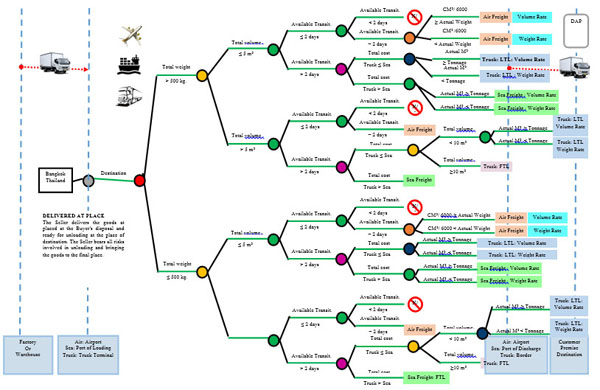
Decision tree diagram of transportation mode selection.
3.6. Intelligent System Diagram
Intelligent System, a system is part of the universe, with a limited extension in space and time. Data which is outside the frontier of the system is called environment. Stronger or more correlations exist between one part of the system and another, than between this part of the system and parts in the environment. An intelligent system learns how to act so it can reach its objectives. The main processes occurring within the intelligent systems are the following: The Intelligent System has a temporary objective, which it has derived from its main objective. It senses its environment, although it clearly shows that it has only a few senses and that these can only capture, for instance, light and sound of an object, but cannot capture or know the object performs the corresponding action. Response rule are system then stores these sense impressions as elementary concepts. Concepts are a material way of storing information. Working on concepts it creates new ones and stores relationships to other total, part, abstract and concrete concepts. In the following we explain this in more detail in Fig. (4).
Data analysis (Thailand – Cambodia).
| Influence Factor | Truck Freight | Maritime Freight | Air Freight |
|---|---|---|---|
| Freight charge | 2 Baht/kg. | 2 Baht/kg. | 56 Baht/kg |
| Transit time | 2 Days | 3 Days | 2 Days |
| Volume(M3) | ≤ 40 m3 | ≥ 5 m3 | ≤ 5 m3 |
| Gross weight | ≤ 23,000 kg. | ≥ 500 kg. | ≤ 500 kg. |
| Value of merchandise | Unlimited | Unlimited | Unlimited |
| Inland transportation cost (Origin) | 0.225 Baht/kg. | 0.225 Baht/kg. | 0.225 Baht/kg. |
| Inland transportation cost (Destination) | 0.225 Baht/kg. | 0.225 Baht/kg. | 0.225 Baht/kg. |
| Customs clearance cost (Origin) | 0.75 Baht/kg. | 0.15 Baht/kg. | 0.15 Baht/kg. |
| Customs clearance cost (Destination) | 0.15 Baht/kg. | 0.15 Baht/kg. |
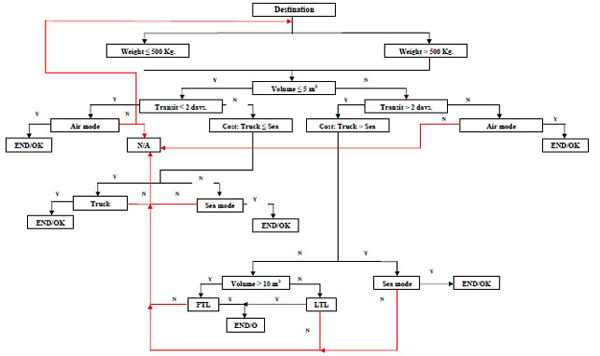
Intelligent system diagram.
The concept used by the system for its internal processing and the word it uses to communicate about the concept. With all the information, expressed as concepts, the system builds up the present situation. Now it looks into its memory and finds applicable response rules. It chooses one of the best it has found and performs the corresponding a field of storage that includes the present situation to which the rule is applicable and the corresponding action. The intelligent system continually records the present situation and the action that followed as a response rule itself.
The very first response rules are due to chance action and to teaching continually records the present situation and the action which followed as a response rule. When the system is externally inactive, in other words, when it sleeps, it reviews the response rules, including these abstractions. Further comparison are between the situation and action of series or recently learned response rules as well as storage in its memory and performs some generalizations. It makes abstractions of concepts and creates the corresponding response rules, including these abstractions. Further comparisons are between the situation and action of a series or recently learned comparisons between situations of different response rules and actions of different response rules. By all these activities, starting with very concrete response rules, it creates response rules that are applicable to several different but similar situations, Fritz, (2006) [14]
This intelligent schematic (Fig. 5) works by reading a value from a table summarizing each record, and then verifies that the clients have to recheck the source and destination countries, the source and destination cities, duration of transportation and the weight of the item whether they are in given range. If criteria were met, it will find the money for the mode of transport. If the customer did not exceed the expenses that are defined either find an appropriate mode of transport, the program will calculate all expenses, and send the results to the customer. But if the expenses exceed the customer is defined, it will store a value in “Required Total Cost Does Not Match” to save it where the appropriate mode of transport that expenses assigned to. However the program will try to find other mode of transport, in case of the appropriate mode of transport is found and expenses not to exceed the customer defined. If the program reads a value from a table summarizing all but have not found an appropriate transport methods, the program will show up in the required total cost does not match ,that is configured is true or not. If it is defined indicates that the customer given expense is less, but if it is not configured in the required total cost, does not match shows that data, the customer completed can't find appropriate mode of transport.
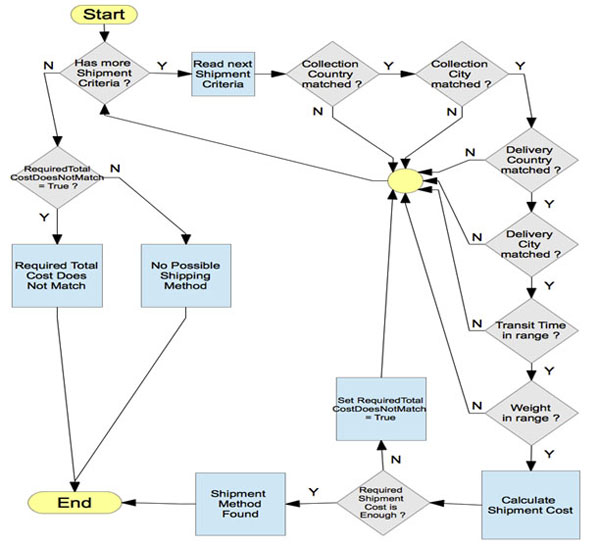
Intelligent schematic.
3.8. Intelligent System Application
Export companies are usually using the services of a Logistics Service Provider (LSP). Original order processing, employees whose duties involve considering the transportation mode selection,Entering data about destination, gross weight, total volume, transit time and total cost as needed. The system display the details about the proper transportation mode recommendation, then take the result from the Intelligent System Program (Fig. 6) to compare the performance and processing of the original process as can be seen in Table 3.
Original process and intelligent system process comparison.
| Description of Method | Operation | Time (min.) | Opr. | Description of Method | Operation | Time (min.) | Opr. |
|---|---|---|---|---|---|---|---|
| Phone / Email |
 |
1 |
 |
||||
| Phone delay | 15 | ||||||
| Write order | 19.8 | ||||||
| Queue in box of method | 19.8 | ||||||
| Order processing | 1 | Order processing | 1 | ||||
| Mode and cost calculation | 180 | 1 | Write order | 19.8 | 1 | ||
| Expert supervising | 45 | Expert system supervising | 1.2 | ||||
| Order entry | Order entry | ||||||
| On order list | 2,880 | On order list | 2,880 | ||||
| Loading | 30 | Loading | 30 | ||||
| Staging | 19.8 | Staging | 19.8 | ||||
| Transportation details | Transportation details | ||||||
| Picking | 45 | Picking | |||||
| To warehouse | To warehouse | ||||||
| Available item | Available item | ||||||
| Stock checking | 19.8 | Stock checking | 19.8 | ||||
| WMS | WMS | ||||||
| Shipping | Shipping | ||||||
| Total | 3,274.2 | 3 | Total | 2,970.6 | 2 |
Export order via original process. Export order via intelligent system program.
| Summary | |||
|---|---|---|---|
| Original Solution | New Solution | ||
| Exporter Order Cycle | Operator | Exporter Order Cycle | Operator |
| 280.6 minutes. | 3 persons. | 21 minutes. | 2 persons. |
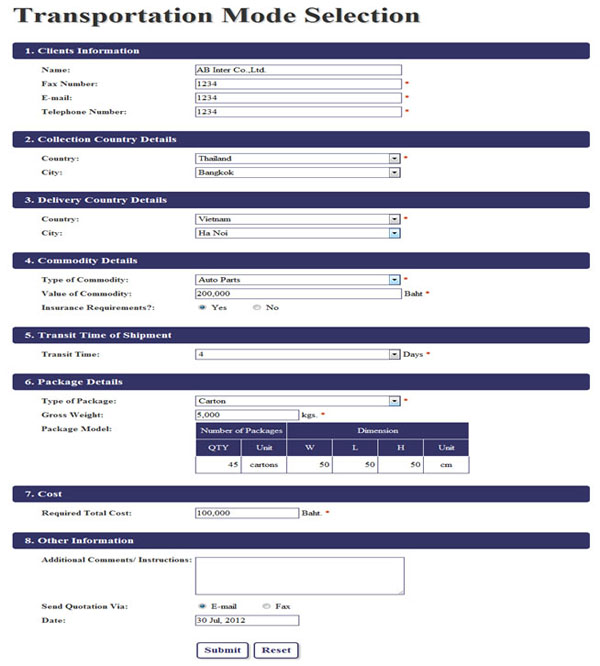
Intelligent system for transportation mode selection program surface.
3.9. Case Study & Result Analysis
The exporter of mobile phone parts in Thailand as one of the major supplier of the world's most important brands, which have been exported from Thailand to Cambodia to accordance with the needs of customers in each interval. Intelligent evaluation system from the program and receive information that is required in the decision to choose the appropriate transport quickly by focus on weight, duration or cost required by entering such information into the program (Fig. 6), which is displayed by a preliminary trial, summarized in Table 4.
Original process and intelligent system process comparison.
| Weight (Kg) | Transit Time (Day) | Mode | Cost (Baht) |
|---|---|---|---|
| 1,500 | 3 | truck | 3,000.00 |
| 1,500 | 2 | Air | 42,000.00 |
| 1,500 | 6 | Sea | 1,500.00 |
| 10,000 | 3 | Truck | 20,000.00 |
| 10,000 | 2 | Air | 280,000.00 |
| 10,000 | 6 | Sea | 10,000.00 |
| 50,000 | 3 | Truck | 100,000.00 |
| 50,000 | 2 | Air | 1,400,000.00 |
| 50,000 | 6 | Sea | 50,000.00 |
CONCLUSION
The appropriate mode of transportation has been an important economical source for industries on ASEAN area. However, this economical region may be jeopardized due to continuing transportation debacles. Hence, it is necessary to examine the problem and determine possible solutions before the repercussions of delays hinder industrial performance.The intelligent system program will be a tool to support the user for the appropriated determine on transportation mode selection under the limitation of lead time, costly, quality of products as well as the complexity of condition and process. The Small and Medium Enterprise (SME) in ASEAN countries who have lack of knowledge on international transportation will be the major group receiving the benefit from this intelligent system program by cost, time, equipment and personal utilization, efficiently.
CONFILICT OF INTEREST
The authors confirm that this article content has no conflict of interest.
ACKNOWLEDGEMENTS
Declared none.


